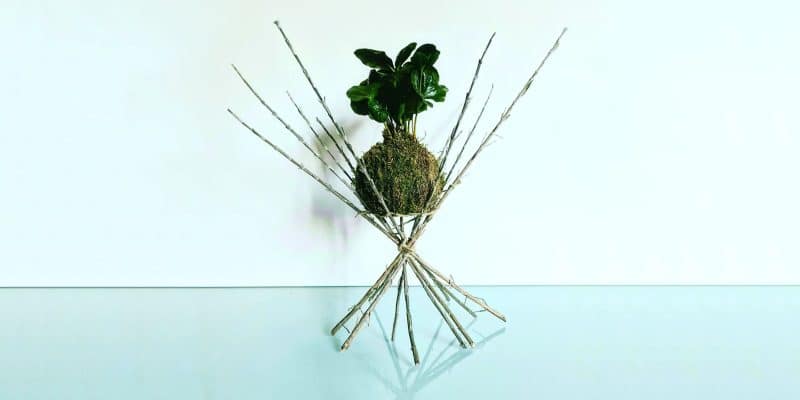A Coffee Plant not only graces your home with its lush foliage but also hints at the possibility of growing your own coffee beans — a caffeine lover’s dream! Although each Coffee Plant makes only about 40 cups of coffee per year, it’s at least a cool conversation piece at parties.
Yep, you heard me right — this dark-leaved beauty really does double as a backup coffee source. And what’s more, it’s a delightful and easy-to-care-for houseplant.
We’ll dive into the world of the Coffee Plant care, from its ideal environment to how to get coffee cherries to develop.
Here’s what you need to know to become a true barista of the botany world!
Table of Contents
Coffee Plant Care Guide
History, Habitat, and Characteristics
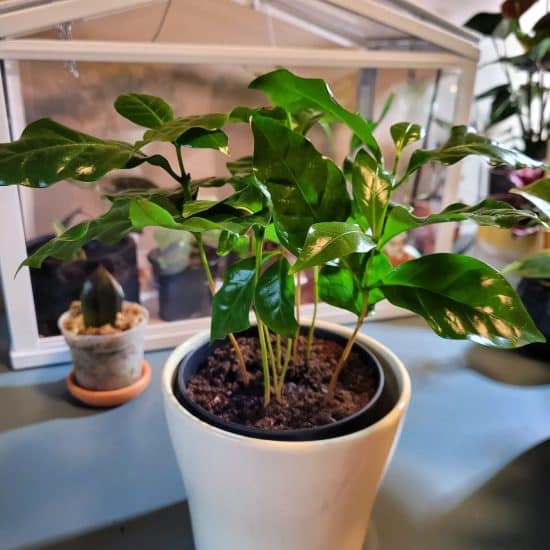
While the genus Coffea consists of thousands of species, Coffee Plants are generally one of two: Coffea arabica and Coffea canephora, aka robusta coffee. Arabica coffee is the world’s most popular coffee variety, and contributes to an incredible 60%-80% of the world’s coffee production.
Coffea Arabica is native to eastern Africa, whereas robusta coffee is native to central and western Africa. In their native habitats, Coffee Plants can reach heights of 6-15 feet, but don’t worry — it’ll stay much smaller grown indoors.
Coffea arabica traveled from Africa by way of the Arabian Peninsula, then India, before reaching Europe in the 17th century. It quickly became a favorite for its stunning dark-green, glossy leaves and, of course, those precious beans.
Coffee didn’t become popular in the United States until the Stamp Act and the resulting Boston Tea Party saw a decline in tea consumption.

Now, if you play your cards right and give your Coffee Plant the care it deserves, you might be greeted by delicate white flowers after three to five years. Cherries are left behind after coffee plant flowers die, and it’s inside these cherries that you’ll find the coveted coffee bean.
Light

Coffee Plants are used to growing under the tree canopy. Grown indoors, they need dappled sunlight, making them perfect for an east-facing window. If you place your plant near a west- or south-facing window, use a sheer curtain to diffuse direct sunlight, which can cause leaf scorch.
In insufficient lighting, your coffee plant may develop pale or yellow instead of glossy green leaves looking pale and yellowing. It may also begin to produce leggy or slow growth. In this situation, the leaves may turn brown and start reaching for any available source — or even fall off.
To increase your plant’s exposure, consider moving it to a brighter location or using an artificial light source, such as an LED, full-spectrum grow lamp.
On the other hand, too much direct sunlight can cause problems too, such as leaf burn, scorched or faded leaves, and small holes appearing in the foliage. If you see these symptoms, add a sheer curtain or move the plant to a shadier spot with brighter light.
Water

Coffee Plants are vigorous growers and adore water, but it’s important to find the right balance. Aim for moist potting soil, like a sponge that’s been drenched and then squeezed out. Avoid making it sopping wet or letting the roots sit in standing water.
Generally, watering your Coffee Plant once a week should do the trick, but it’s always a good idea to regularly check the moisture level instead of going by schedule alone. It’s also a good practice to use distilled water because these plants can sometimes be sensitive to the minerals present in tap water.
When winter rolls around, ease off on the watering — coffee trees require both wet and dry seasons for optimal fruit production. In winter, it’s okay to let the soil dry out a bit.
A Coffee Plant will usually droop when it’s gone too long without water. If your Coffee Plant is consistently not getting enough water, you may get dry, crispy, or curled leaves where you should have glossy leaves, and the plant’s growth may slow down or even wilt. To fix this, increase the frequency of watering and maintain consistent soil moisture.
On the other hand, too much water can lead to yellow leaves, soft brown spots, and waterlogged or rotting roots. If you spot these problems, it’s time to reduce how often you water your plant and let the soil dry out slightly in between watering sessions.
Temperature and Humidity
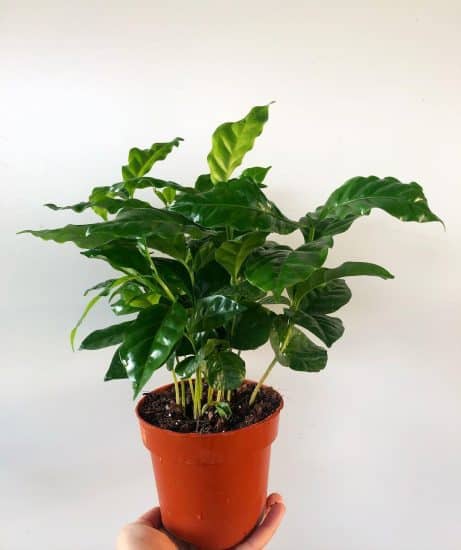
Since Coffea arabica and robusta coffee originate from tropical mountains and rainforests, they love a humid environment and thrive in specific temperature ranges.
Coffee Plants prefer temperatures ranging from 70 to 80°F (17 to 21°C). Keep your plant away from areas with hot or cold drafts, such as windows, doors, and vents, which can damage both the leaves and roots.
You also need to give your Coffee Plant moist air. A humidity level of at least 60% is crucial for the health of your Coffee Plant. If you notice the leaves starting to droop or the tips turn brown, this could be a sign that the humidity level is too low.
Humidity tips:
- Run a humidifier near your Coffee Plant for a few hours each day.
- Place your Coffee Plant on a humidity tray filled with water and pebbles to increase indoor humidity.
- Group your Coffee Plant with other humidity-loving plants.
- Wipe down the leaves with a moist cloth to remove dust and potential pests, instead of misting them directly.
Soil and Planting

A Coffee Plant requires a loamy, acidic soil mix that retains moisture but still has good drainage.
Our recommended soil mix:
- 7 parts coconut coir
- 2 parts perlite
- 2 parts worm castings
To achieve the right soil acidity, consider adding compost (avoid sphagnum peat moss — it’s notoriously bad for the environment) and monitoring pH levels. You can try adding sulfur to the soil to increase acidity, but do so in increments to avoid overdoing it.
Signs of poor soil and inappropriate potting mix can include yellowing leaves, slow growth, and weak stems. If you notice these issues, you may need to adjust your potting mix and ensure there is proper drainage.
These signs may also indicate you need to repot your Coffee Plant, which usually needs to be done every 2-3 years in springtime. Use the soil mix described above and replant in a pot that is only a few inches wider and taller.
Fertilizer
Coffee Plants are best fertilized while they show active growth in spring and summer, which will encourage fruiting. You can use any balanced liquid fertilizer as you water. Make sure to cut back significantly in the winter during dormancy.
Be mindful of the signs of too much fertilizer, including burnt leaf tips, wilted leaves, and excessive leaf drop. If you suspect over-fertilization, flush the soil with water to remove excess fertilizer and reduce future applications.
How to Get a Coffee Plant to Produce Fruit and Coffee Beans

- Allow your plant to mature. Coffee Plants typically start flowering after 3 or 4 years, so be patient and give them time to grow.
- Ensure proper lighting. Place your Coffee Plant in bright, indirect sunlight.
- Provide consistent care. Water your Coffee Plant regularly, keep the humidity up, and fertilize with a balanced houseplant fertilizer. These factors contribute to a healthy, happy plant that’s more likely to reward you with fruit.
- Look out for flowers. Once your plant begins to flower, its delicate little blooms will eventually transform into cherries containing coffee beans. This is the moment you’ve been waiting for!
- Harvest at the right time. When the cherries turn a glossy, deep red, it’s time for you to reap the fruits of your labor. After harvesting, you’ll need to process, dry, and roast the beans before enjoying your homegrown coffee delight.
Propagation Guide

If you love your Coffee Plant and want more of a good thing, you can propagate new Coffee Plants and ensure that you can enjoy those same beans or give them to friends.
We recommend propagating Coffee Plants using stem cuttings, but air layering works too if you’re feeling adventurous.
Propagating Coffee Plants by stem cuttings:
- Spot the perfect stem. First things first, find a good-looking, healthy stem with about 3 to 4 leaves.
- Prep your cutting. Grab sterilized gardening shears and snip a 4-6″ segment of the stem, ideally below a leaf node. Remove the leaves from the bottom nodes to free them up for rooting and avoid any soggy leaf situation in the water.
- Place your cutting in water. Fill a small, clear container with filtered water and gently place your cutting in it. For extra humidity, you can cover the container with a plastic bag or a 2-liter soda bottle cut in half.
- Keep an eye on your plantling. Place your cutting in a bright spot with indirect sunlight, and change its water every couple of days. Don’t let it catch too much full sun, which may stress out the cutting and mess with the propagation.
- Plant your cutting. In a few weeks, you’ll see a healthy white root structure about 2 inches long. You know what that means! Time to transplant the cutting into a pot filled with well-draining, acidic soil. Remember not to overwater – these plants like it moist, not flooded.
Propagation tips:
- Timing is everything. Propagation works best during the early summer, but really any spring, and summer months will do. If you want to give it a go during winter, make sure there’s plenty of the right light and humidity.
- Rooting hormone (optional): To bump up your chances of success, consider dipping the ends of your cuttings in rooting hormone. This encourages quicker rooting and stronger, healthier roots.
Common Issues
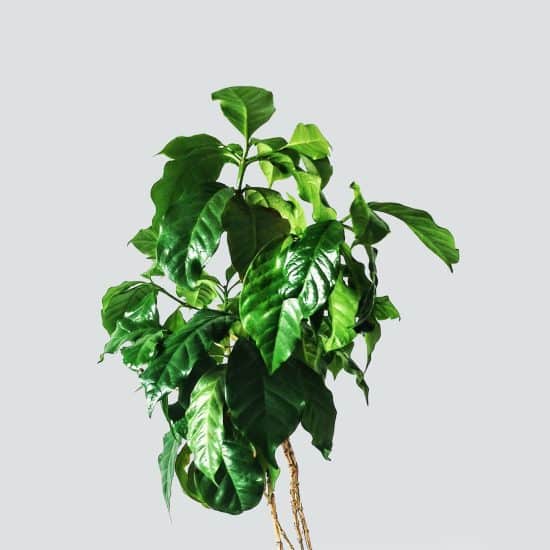
Brown Leaves
If your arabica or robusta Coffee Plant is languishing in direct sunlight, it’s going to feel the burn, and those leaves will turn brown at the tips and edges. Brown leaf tips are your cue to find a cozier spot with bright, indirect light near an east- or west-facing window.
Oh, and don’t forget to water consistently! Keep the acidic soil moist (but not soaking wet) to show your plant some love and watch those leaves thrive.
Slow Growth
If your Coffee Plant’s growth slows, it could be due to propagating during the fruiting stage. Pruning can send a message to your plant like, “Hey, let’s pump the brakes on the fruit and focus on new growth instead.”
To figure this out, think back — did you recently prune your plants? Or does it seem like it’s putting all its energy into new shoots and leaves? If that’s the case, it’s time for a change. Just let your plants be during the fruiting stage — no more pruning. It’s important to also make sure they’re getting enough water and nutrition for those beans to finally make an appearance after a few years!
Other causes for slow growth include insufficient nutrients, water, or sunlight. Evaluate your Coffee Plant care, and make changes where needed.
Pests and Diseases

Spider Mites
Spider mites are so tiny, yet so destructive! If you’re seeing tiny webs near the base of the leaves, or mysterious yellow spots, spider mites have probably set up camp.
It’s important to keep them contained — isolate your Coffee Plant from your other houseplants. Gently wipe the leaves with a damp cotton swab or cloth. This helps get rid of the mites and their tiny webby homes. If things are looking really bad, you might want to bring in the big guns and use a miticide or neem oil spray on your Coffee Plant (just follow the directions on the label).
To keep these uninvited guests from coming back, make a habit of cleaning your Coffee Plant’s leaves and watching for any early signs of mite mischief. Also, increase the humidity around your Coffee Plant. Spider mites love dry conditions. You know what they say — prevention is the best medicine!
Root Rot
This happens when your Coffee Plant’s roots get too wet from overwatering or poor drainage. You might notice yellowing, wilting leaves or even a funky smell coming from the potting mix.
Take your plant out of its pot and remove any roots that look brown, black, or just super mushy. Always sanitize your cutting tool before and after use to avoid spreading fungal diseases around. Now, repot your Coffee Plant in a mix with good drainage and aeration. We’re talking perlite, pumice, or even LECA! And while we’re at it, pick a pot with better drainage holes, too.
To avoid playing the root rot game again, make sure your plant is ready for water before you water it. This may mean sticking your finger in the soil and feeling for moisture. (Studies show that contact with soil increases serotonin levels in the brain.) Don’t let your plant sit in standing water. If you use a drip saucer (which you should), dump it when your Coffee Plant is done draining.
Conclusion
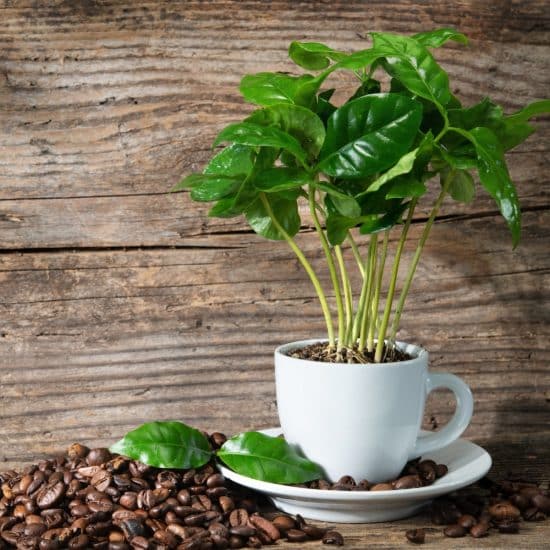
That’s a wrap for our Coffee Plant care and growing guide!
Coffea arabica is an enchanting houseplant that not only makes a beautiful addition to your indoor garden but can also reward you with fragrant white flowers and your very own coffee beans. If you like espresso or an otherwise bitter coffee flavor, you can always try growing robusta coffee, though it may be harder to find.
Coffee Plant care summary:
- Provide bright, indirect sunlight and avoid direct sunlight to prevent leaf burn.
- Water your Coffee Plant about once a week, maintaining moist soil without making it too wet.
- Maintain a temperature range of 70-80°F (17-21°C) and at least 60% humidity.
- Use a well-draining soil mix to prevent root rot, and repot when necessary.
- Fertilize during the growing season and cut back during winter to promote healthy growth and fruiting.
We hope this article has given you helpful knowledge on how to care for your Coffee Plant. If you have any questions or need more information, don’t hesitate to reach out to us.
And if you found this guide helpful, share it with your fellow plant-loving friends!
Happy growing, and maybe wake up and smell the coffee . . . plant!
FAQ
Do Coffee Plants smell like coffee?
While the Coffee Plants themselves don’t quite smell like the cup of joe you know and love, the magic happens when they bloom: delicate white flowers with a hint of jasmine fragrance. In fact, these sweet-scented blossoms are the precursors to coffee beans.
Can Coffee Plants be grown anywhere indoors?
The short answer is, yes! Coffee Plants can thrive in a variety of indoor environments, as long as certain conditions are met.
Bear in mind that Coffee Plants are accustomed to the shady understory of tropical forests, so it’s essential to recreate that environment as best you can indoors. This means bright, indirect light, high humidity, a 65-75°F (18-24°C) temperature range, and a well-draining, slightly acidic potting mix. If you don’t have indirect bright sunlight anywhere in your home, you can always use an artificial grow lamp.

